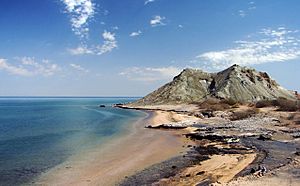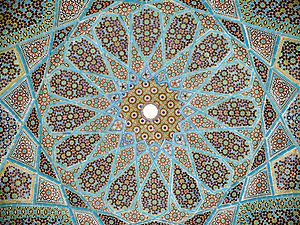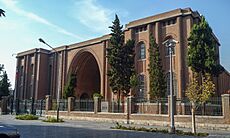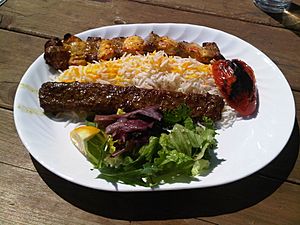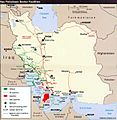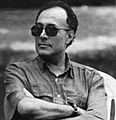Iran facts for kids
Quick facts for kids
Islamic Republic of Iran
|
|
|---|---|
|
Anthem: سرود ملی جمهوری اسلامی ایران
Sorud-e Melli-ye Jomhuri-ye Eslâmi-ye Irân "National Anthem of the Islamic Republic of Iran" |
|
| Capital and largest city
|
Tehran 35°41′N 51°25′E / 35.683°N 51.417°E |
| Official languages | Persian |
| Demonym(s) | Iranian |
| Government | Unitary presidential theocratic Islamic republic |
| Ali Khamenei | |
| Masoud Pezeshkian | |
| Mohammad Reza Aref | |
| Legislature | Islamic Consultative Assembly |
| Formation | |
|
• Median kingdom
|
c. 678 BC |
| 550 BC | |
| 1501 | |
| 1736 | |
| 12 December 1905 | |
|
• Pahlavi Iran
|
15 December 1925 |
| 11 February 1979 | |
|
• Current constitution
|
3 December 1979 |
| Area | |
|
• Total
|
1,648,195 km2 (636,372 sq mi) (17th) |
|
• Water (%)
|
1.63 (as of 2015) |
| Population | |
|
• 2024 estimate
|
|
|
• Density
|
55/km2 (142.4/sq mi) (132nd) |
| GDP (PPP) | 2024 estimate |
|
• Total
|
|
|
• Per capita
|
|
| GDP (nominal) | 2024 estimate |
|
• Total
|
|
|
• Per capita
|
|
| Gini (2022) | ▼ 34.8 medium |
| HDI (2022) | high · 78th |
| Currency | Iranian rial (ریال) (IRR) |
| Time zone | UTC+3:30 (IRST) |
| ISO 3166 code | IR |
| Internet TLD | |
Iran officially the Islamic Republic of Iran (Persian: ايران), historically known as Persia, is a country in Western Asia. It is part of the Middle East region. It shares borders with Afghanistan, Armenia, Azerbaijan, Iraq, Pakistan, Turkey, and Turkmenistan.
Tehran is the capital and biggest city. Iran is the eighteenth largest country in the world. It has more than 84.9 million people. Iran has been a member of the United Nations since 1945. It is a member of the Organization of the Petroleum Exporting Countries (OPEC). It is an Islamic republic.
In Iran, Persians, Azerbaijanis, Kurds, Mazandaranis, Gilaks, Lurs and Bakhtiaris make up the nations minority ethnic groups.
Contents
History
In the past, Iran was called "Persia" by people outside of the country. The people that lived there called the country "Iran". The official name was Persia, a region in Iran. The name Persia was used when dealing with other countries and in government papers.
In 1935, Reza Shāh Pahlavi was Shah of Iran. He officially asked foreigners to call the country "Iran". This was done to show that Iran belongs to all the non-Persian Iranians as well as to Persian Iranians. The name Iran means land of the Aryans. It is used in the ancient book of the Zoroastrians, the Avesta. In the 19th and early 20th century, the name Aryan was used by Europeans to mean all Indo-Europeans. The "Aryan Race" was a term that Hitler used to describe his "Superior" or "perfect" race, but it first meant Iranians. "Aryan" means "noble" in Iranian languages.
Persian Empire
Around 500 BC, the area that is now Iran was the center of the Achaemenid Empire. The Greek city states fought against the Persian armies led by Darius the Great and Xerxes. Then Alexander the Great took the country by fighting the Achaemenid dynasty of Persia. He ruled until he died,then the Greek Seleucids ruled until they were defeated by the Parthian Empire which later fought the Roman Empire.
After the Parthians, the Sassanian dynasty (224-651) took over. Other people took Persia by fi\ghting, like the Arabs (7th century), Turks (10th century) and Mongols (13th century). However, Iran has always had a different culture and continued to survive.
After World War II
The Central Intelligence Agency (CIA) worked in Iran to create 1953 riots which led to the removal of Prime Minister Mosaddegh. The United States and Great Britain then made the Shah Mohammad Reza Pahlavi the most powerful person in Iran, again. The Shah left Iran in 1979 in the face of a revolt. The Iranian government was changed to an Islamic Republic by Islamic Revolution. Soon afterwards, the Iranian Students Movement (Tahkim Vahdat), with the backing of the new government, took over the U.S. Embassy in Tehran. They held most of the diplomats hostage for 444 days.
Relations between the two countries have not been good since. For example, the United States claims that Iran supports terrorist groups against Israel. Iran does not see Israel as a country. Iran, along with most Arab countries, believes that Israel does not have the right to exist. However, Iran has collaborated with the West at times. These deals have been about energy or about fighting terrorism.
Iran fought the Iran–Iraq War in the 1980s. Many foreign countries supported Iraq.
Now, the West is trying to prevent Iran from using nuclear technology, even though Iran is a member of the Nuclear Non-Proliferation Treaty. The International Atomic Energy Agency (IAEA) has reported many times that there is no evidence that Iran is developing nuclear weapons. However, it also says that it can not say for sure that Iran is not doing so in secret.
A December 2007 CIA report on nuclear activity in Iran said that Iran's secret program to get nuclear weapons technology was stopped in 2003. It said that Iran will probably not be able to build a nuclear weapon soon.
Economy
Iran has the natural resource of oil. It is a member of OPEC. Oil is one of its main exports. Rice, handicrafts, carpets and crocus are important local products. Iran is the world's largest exporter and producer of caviar. Iran is also one of the world's biggest exporters of pistachio nuts.
Iran has factories that produce industrial products. Iran is also involved in the field of biomedical sciences.
Rial is the money used in Iran.
Religion in Iran
About 90% of Iranian people are Muslim. The state religion is Shia Islam. It has been the state religion since the Safavid dynasty in the 16th century. This is the religion of about 75% of Iranians. They belong to the Twelver branch. About 9% of Iranians Muslim belong to the Sunni branch of Islam. The 9% of Iranians who are not Muslim are Bahá'ís, Mandeans, Zoroastrians, Christians and Jews. It is thought that there are between 300,000 and 350,000 Persian (Iranian) Jews.
Regions and provinces
Languages
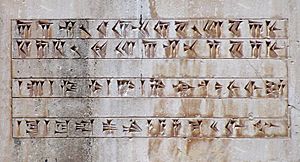
The majority of the population speaks Persian, the official language of the country. Others include speakers of several other Iranian languages within the greater Indo-European family and languages belonging to some other ethnicities living in Iran.
Percentages given by the CIA's World Factbook include 53% Persian, 16% Azerbaijani, 10% Kurdish, 7% Mazenderani and Gilaki, 7% Luri, 2% Turkmen, 2% Balochi, 2% Arabic, and 2% the remainder Armenian, Georgian, Neo-Aramaic, and Circassian.
Architecture
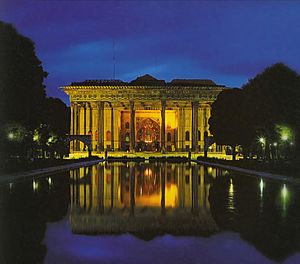
The history of architecture in Iran dates back to at least 5,000 BC with characteristic examples distributed over a vast area from what is now Turkey and Iraq to Uzbekistan and Tajikistan, and from the Caucasus to Zanzibar. The Iranians made early use of mathematics, geometry and astronomy in their architecture, yielding a tradition with both great structural and aesthetic variety. The guiding motif of Iranian architecture is its cosmic symbolism. Iranian architecture displays great variety, both structural and aesthetic, from a variety of traditions and experience.
Without sudden innovations, and despite the repeated trauma of invasions and cultural shocks, it developed a recognizable style distinct from other regions of the Muslim world. Its virtues are "a marked feeling for form and scale; structural inventiveness, especially in vault and dome construction; a genius for decoration with a freedom and success not rivalled in any other architecture".
In addition to historic gates, palaces, and mosques, the rapid growth of cities such as the capital Tehran has brought about a wave of construction. Iran ranks seventh among UNESCO's list of countries with the most archaeological ruins and attractions from antiquity.
World Heritage Sites
Iran ranks 10th globally in terms of UNESCO-listed monuments, with 27. These include Persepolis, Naghsh-e Jahan Square, Chogha Zanbil, Pasargadae, Golestan Palace, Arg-e Bam, Behistun Inscription, Shahr-e Sukhteh, Susa, Takht-e Soleyman, Hyrcanian forests, the city of Yazd and more. Iran also has 24 Intangible Cultural Heritage, or "Human treasures", which ranks 5th worldwide.
Museums
The National Museum of Iran in Tehran is the country's most important cultural institution. As the first and biggest museum in Iran, the institution includes the Museum of Ancient Iran and the Museum of the Islamic Era. The National Museum is the world's most important museum in terms of preservation, display and research of archaeological collections of Iran, and ranks as one of the few most prestigious museums globally in terms of volume, diversity and quality of its monuments.
There are many other popular museums across the country such as the Golestan Palace (UNESCO World Heritage Site), The Treasury of National Jewels, Reza Abbasi Museum, Tehran Museum of Contemporary Art, Sa'dabad Complex, The Carpet Museum, Abgineh Museum, Pars Museum, Azerbaijan Museum, Hegmataneh Museum, Susa Museum and more. In 2019, around 25 million people visited the museums.
Cuisine
Iranian main dishes include varieties of kebab, pilaf, stew (khoresh), soup and āsh, and omelette. Lunch and dinner meals are commonly accompanied by side dishes such as plain yogurt or mast-o-khiar, sabzi, salad Shirazi, and torshi, and might follow dishes such as borani, Mirza Qasemi, or kashk e bademjan. In Iranian culture, tea is widely consumed. Iran is the world's seventh major tea producer. One of Iran's most popular desserts is the falude. There is also the popular saffron ice cream, known as Bastani Sonnati ("traditional ice cream"), which is sometimes accompanied with carrot juice. Iran is also famous for its caviar.
Typical Iranian main dishes are combinations of rice with meat, vegetables and nuts. Herbs are frequently used, along with fruits such as plums, pomegranates, quince, prunes, apricots and raisins. Characteristic Iranian spices and flavourings such as saffron, cardamom, and dried lime and other sources of sour flavoring, cinnamon, turmeric and parsley are mixed and used in various dishes.
Related pages
Images for kids
-
Inscription of Ardeshir Babakan (r. 224–242) in Naqsh-e Rostam: "This is the figure of Mazdaworshiper, the lord Ardashir, Shahanshah of Iran..."
-
An Ashrafi Coin of Nader Shah (r. 1736–1747), reverse:"Coined on gold the word of kingdom in the world, Nader of Greater Iran and the world-conquerer king."
-
A cave painting in Doushe cave, Lorestan, from the 8th millennium BC
-
A bas-relief at Persepolis, depicting the united Medes and Persians
-
Tomb of Cyrus the Great, founder of the Achaemenid Empire, in Pasargadae
-
Tomb of Hafez, a medieval Persian poet whose works are regarded as a pinnacle in Persian literature and have left a considerable mark on later Western writers, most notably Johann Wolfgang von Goethe, Henry David Thoreau, and Emerson
-
Venetian portrait, kept at the Uffizi, of Ismail I, the founder of the Safavid Empire
-
Statue of Nader Shah, the first Afsharid ruler of Iran, at his Tomb
-
A map showing the 19th-century northwestern borders of Iran, comprising modern-day eastern Georgia, Dagestan, Armenia, and the Republic of Azerbaijan, before being ceded to the neighboring Russian Empire by the Russo-Iranian wars
-
The first national Iranian Parliament was established in 1906 during the Persian Constitutional Revolution
-
Reza Shah, the first Pahlavi king of Iran, in military uniform
-
The Allied "Big Three" at the 1943 Tehran Conference.
-
Mohammad Reza Pahlavi and the Imperial Family during the coronation ceremony of the Shah of Iran in 1967.
-
An Iranian soldier wearing a gas mask on the front line during the Iran–Iraq War
-
The Green Movement's Silent Demonstration during the 2009–10 Iranian election protests
-
The 2017–18 Iranian protests were initiated on 31 December 2017 and continued for months.
-
Mount Damavand, Iran's highest point, is located in Amol, Mazenderan.
-
Persian leopard, listed as Endangered on the IUCN Red List.
-
Iran holds 10% of the world's proven oil reserves and 15% of its gas. It is OPEC's second-largest exporter and the world's 7th largest oil producer.
-
Iron Age gold cup from Marlik, kept at New York City's Metropolitan Museum of Art
-
Kamal-ol-Molk's Mirror Hall, often considered a starting point in Iranian modern art
-
Zoroaster, the founder of Zoroastrianism, depicted on Raphael's The School of Athens
-
The Roudaki Hall, constructed between 1957 and 1967 in Tehran
-
Abbas Kiarostami (1940–2016), an acclaimed Iranian film director
-
Behrouz Vossoughi, a well-known Iranian actor who has appeared in more than 90 films
-
Haft-Seen, a customary of Nowruz, the Iranian New Year
-
An Iranian tea (čāy) tray served near Garden of Mausoleum of Omar Khayyam in Nishapur
-
The Azadi Stadium in Tehran is West Asia's largest football stadium.
See also
 In Spanish: Irán para niños
In Spanish: Irán para niños






